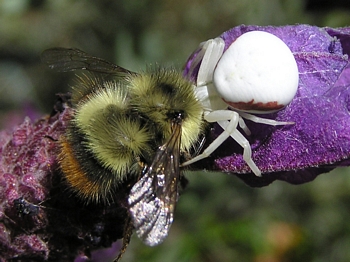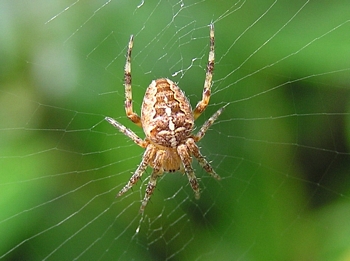| |
Those Creepy Crawlies...the Secret World of Spiders |
| |
|
| |
We all know that some spiders make webs and catch their prey - but not all. Other spiders hunt using different methods such as stalking and jumping.
The Stalkers
A successful human stalker, perhaps out stalking animals to photograph, may don camouflage of various colours to hide or blend in with the surroundings. However, stalking spiders can't do this and so some have the most amazing ability to change colours to suit the flower of choice! |
| |
 |
__ |
 |
| |
|
|
 |
|
The five images in this section are of Goldenrod Crab Spiders, Misumena vatia, known for the ability to change its colour from white to yellow.
Notice how the spider on the left is white, red and green, blending in with the flower it is on.
This is a very effective method of hunting as the spider can sneak up on bees pollinating the flower. |
| |
|
 |
|
 |
Camouflage isn't always needed.
These bees were easily caught in this lavender plant by a very un-camouflaged stalker! |
| |
|
|
The Jumpers
Jumping spiders are fascinating leaping stars of the spider world. The observe using their big eyes and have excellent eye site. Like all spiders they have four pairs of eyes giving them 360 degree eyesight. Their eyes are also capable focusing by moving out or inwards as well as turning up and down, left and right. Furthermore, the spider can turn its carapace (breast) to look around.
|
 |
|
 |
Both images: Boreal Jumping spiders Phidippus sp. |
You'll find these spiders almost everywhere on sunny days, lurking on flowers, shrubs, grasses and rocks. Once prey is spotted, they track, stalk and calculate the jumping distance, suddenly leaping out, propelled by their strong back legs. If you observe a jumping spider, you'll see that it always releases a life-line when it leaps or drops down.
Although Jumping spiders are generally small (up to 12 mm) they can be fun to observe as they have an inquisitive nature, often striking colours and of course amazing jumping abilities. |
| |
|
|
The Web Builders
Everyone has seen a cobweb in the garden or often mysteriously appearing dusty, forgotten corners in the house. Building webs is the third hunting method of spiders. A web is carefully constructed with the hope that something tasty wanders along or flies in and gets trapped. Sometimes, web builders will wrap its prey up to immobilize it before administering a fatal bite. Here are two web builders: |
 |
|
 |
Cross spider, Araneus diadematus
This garden spider builds large webs often two to three feet across, hanging from shrubs three to six feet off the ground. Webs are usually built after dusk as the spider likes to hide away in leaves or trees during the day. Undamaged webs will be left for the next night of hunting. |
|
Hackled-mesh Weaver, Amaurobiidae sp.
You'll notice how the web of this spider is fluffy and not sticky. It's believed that the silk is charged with static electricity and the thready fluffs tangle the prey as it tries to escape. |
| |
|
|
Many people really don't like spiders! However, it's hard to deny that spiders really are interesting little (generally!) animals. We hope that this page will give you a renewed interest and encourage you to explore The Secret World of Spiders. |
| |












